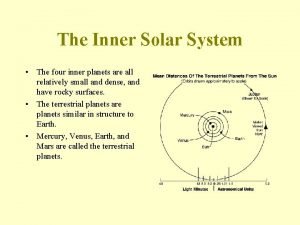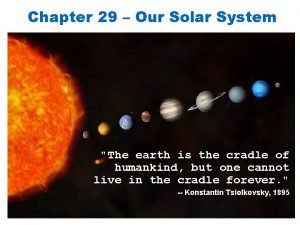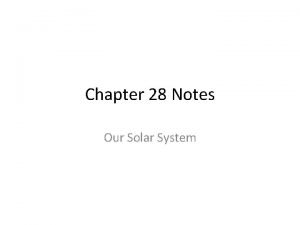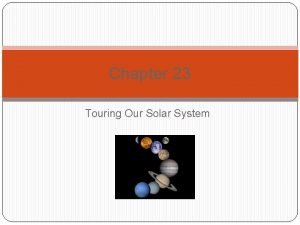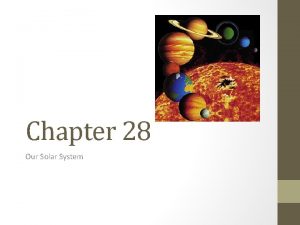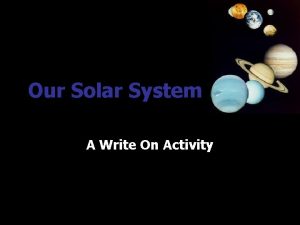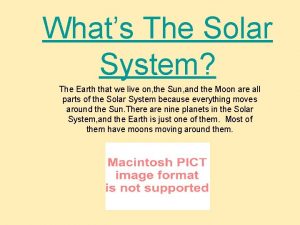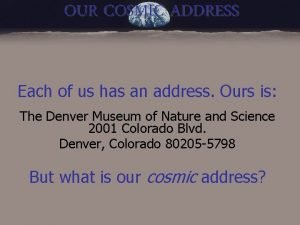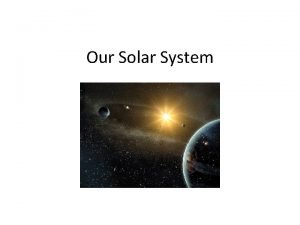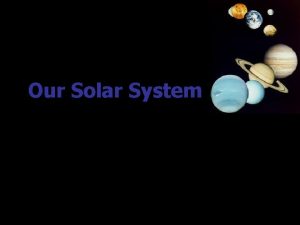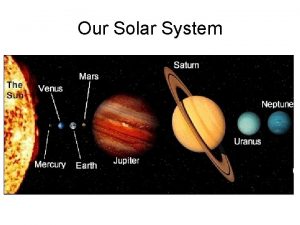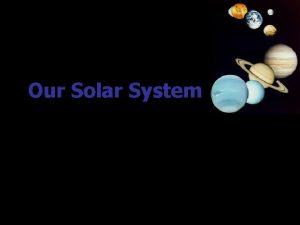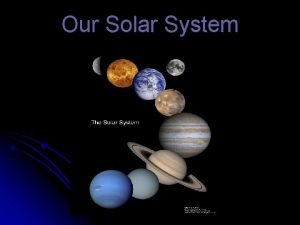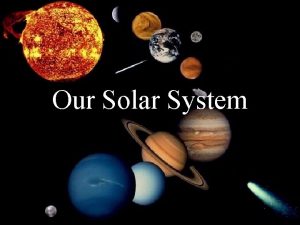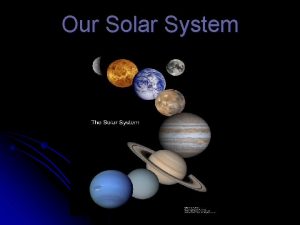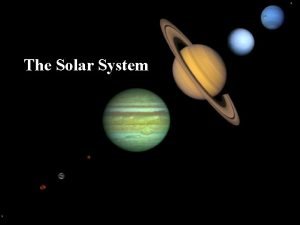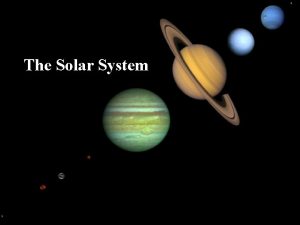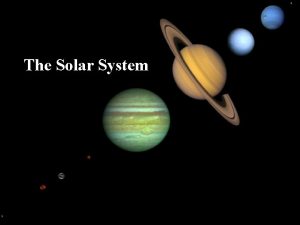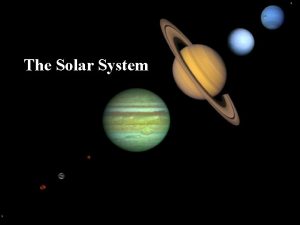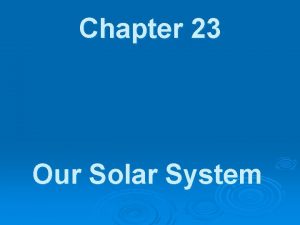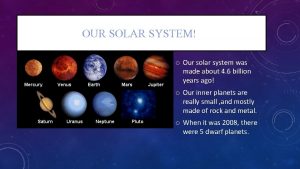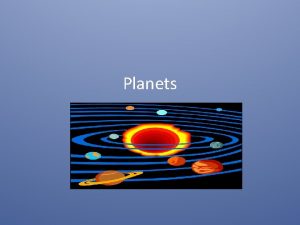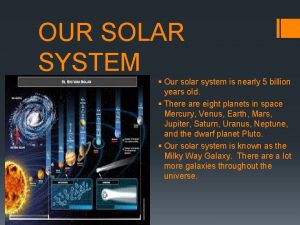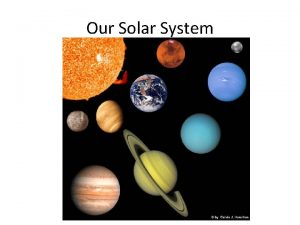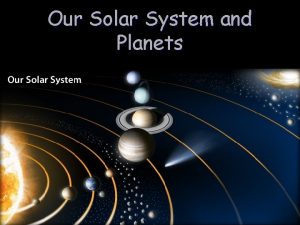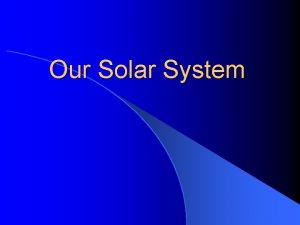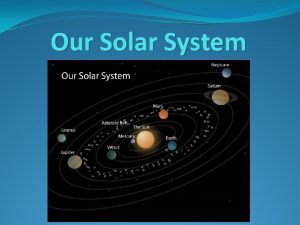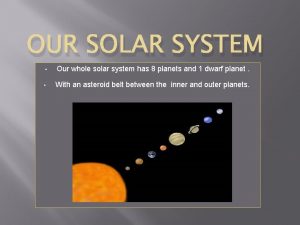The Solar System Whats in Our Solar System






























































- Slides: 62

The Solar System

What’s in Our Solar System? • Our Solar System consists of a central star (the Sun), the eight planets orbiting the sun, several dwarf planets, moons, asteroids, comets, meteors, interplanetary gas, dust, and all the “space” in between them. • Solar System: a star (sun) together with all the objects revolving around it (planets and their moons, asteroids, comets, and so on).

What’s in Our Solar System? • The word solar comes from the Latin solaris, meaning “of the sun. ” Sol is the Latin word for “sun. ” • The eight planets of the Solar System are named for Greek and Roman Gods and Goddesses.

Planetary System: a planet with its moon(s), • The Earth and moon are a planetary system. • The word planet comes from a Greek word meaning “wandering. ” To the ancients, the five visible planets to the naked eye appeared to move, unlike the other fixed stars that were “fixed. ” • Orbit: the path followed by a planet, asteroid, or comet around a star, or a moon around a planet. The word comes from the Latin orbita, meaning a “wheel track. ”

Planets, Dwarf Planets, Moons, Asteroids, and Comets • Planet: a large body, spherical because of its own gravity, orbiting a star and not sharing its orbit with any other large bodies. • Dwarf Planet: a planet-like body that orbits the sun and does not clear its orbital zone of other massive bodies, and is not a moon. • Moon: object revolving around a planet. The word moon is from an ancient German root meaning “moon” or “month. ”

Planets, Dwarf Planets, Moons, Asteroids, and Comets • Asteroid: a rocky or metallic object a few feet or a few miles in dimeter. It may orbit alone or be in a belt of many other asteroids. The word asteroid comes from the Greek aster (“star”) and -oid (“-like”). They have no atmosphere or water. • Meteor: small rocky or metallic object heated to incandescent vapor as it falls or streaks into Earth’s atmosphere. Those streaks are called “shooting stars. ” – Meteoroid: meteor in space – Meteorite: meteor that survived its passage through the atmosphere and strikes the ground. The Greek root for rock is “-ite. ” • Comet: icy object that, when passing close enough to its star, displays a tail of evaporated material. The word comet comes from the Latin stella cometa, meaning “long-haired star”, referring to the tail.

Composition and Structure of the Solar System The Solar System consists of: • The sun • Eight planets, including Earth • At least five dwarf planets, including Pluto • Over 100 moons • Large numbers of asteroids and comets Geocentric = Earth Centered (Aristotle, Ptolemy) Heliocentric = Sun Centered (Copernicus, Galileo) *Copernicus was the first astronomer to accurately describe out solar system.

Composition and Structure of the Solar System • The sun is the largest object in our solar system. It’s the center of our solar system, and all other objects in our solar system revolve around it. • The cause of this arrangement is gravity. Gravity is a property of space and time that causes both weight and orbits. The word gravity comes from the Latin gravitas, meaning “weight” or “heaviness. ” Because of gravity, small objects either drops onto larger, heavier objects or orbit around them.

Composition and Structure of the Solar System The 8 Planets in order from the sun outward: • Mercury • Venus • Earth • Mars • Jupiter • Saturn • Uranus • Neptune -Most of the asteroids in our solar system are in two belts. -Asteroid Belt: lies between the orbits of Mars & Jupiter. -Kuiper Belt: collection of icy objects that orbit beyond Neptune. -Oort Cloud: a huge zone of icy objects lying far beyond the Kuiper Belt. When something disturbs one of these objects, it fall in toward the sun in elongated orbit and becomes a comet. Most of the comets in our solar system originate in the Oort Cloud.

Motions of the Planets • Revolution: the planets all revolve around the sun in a single plane, like a disc. • Rotation: Each planet rotates on its axis. The axis is an imaginary rod running through the center of the planet and each of the geographic poles. – Axis is a Latin word meaning “axle. ” – The axes of the planets are tilted varying amounts to the common plane of revolution. – Earth’s axis is tilted about 23. 5° - this is what causes the seasons.

Inner and Outer Planets • Inner Planets: – Mercury – Venus – Earth – Mars • Outer Planets – Jupiter – Saturn – Uranus – Neptune – Pluto


The Relative Size of the Planets in the Solar System

The Scale of the Solar System The illustration on the previous slide is not true to scale. In fact, it is wildly out of scale. To understand the true scale of the solar system, imagine the Earth is the size of your classroom globe, THEN: -The sun, at the center of the solar system, is a sphere 14 stories tall. -Mercury is a grapefruit and 1. 25 miles from the sun. -Venus is a beach ball and 2. 25 miles from the sun. -Earth, the size of a globe, is 3 miles from the sun. *The moon is a baseball and 40 feet from Earth. -Mars is a dodgeball and 4. 5 miles from the sun. -Jupiter is as wide as five vans and 15. 5 miles from the sun. -Saturn is as tall as a basketball hoop and 29 miles from the sun. -Uranus is as tall as the average male 8 th grader (5’ 4) and 57 miles from the sun. -Neptune is as tall as the average male 6 th grader and 90 miles from the sun. *Light takes 8 minutes to reach Earth, and 4 hours to reach Neptune. It takes light less than 3 seconds to travel from the Earth to the moon and back.

The 8 Planets of the Solar System • Planets are categorized according to composition and size. There are two main categories of planets: – small Rocky Planets (Mercury, Venus, Earth, and Mars): rocky planets also known as “terrestrial planets” meaning earth-like. Terra is Latin for “earth. ” These planets are composed mainly of rocks and metals. When the solar system was forming the heavier elements tended to collect closer to the sun. Venus, Earth, and Mars have atmospheres composed of gases. Earth is unique because it has a large amount of water. Rocky planets, being heavy, rotate more slowly. – Gas Giants (Jupiter, Saturn, Uranus, and Neptune): composed mostly of hydrogen and helium. Uranus and Neptune are sometimes called “ice giants, ” because they contain ices of water, ammonia, and methane. Each of the gas planets has a small solid core. Being lighter, they rotate faster, this casues high winds andhuge storms. The gas planets have rings and multiple moons.

The Sun • • Diameter: 865, 000 miles (109 times greater that Earth) Distance from Earth: 93 Million Miles – This is know as 1 AU (astronomical unit) and is used to measure interplanetary and interstellar distances. • • Rotation: rotates on its axis in about 25 earth days. Characteristics: – The sun is a fairly ordinary main sequence star. – Its very bright – 85% brighter than other stars in our galaxy – Its white in color, however it looks yellow because of our atmosphere. – Surface Temp: 10, 000°F – Core Temp: 27 Million °F • A star’s temperature determines its “color. ” The coldest stars are red. The hottest stars are blue. • Composition: 75% Hydrogen & 25% Helium

The Sun • Other Facts: – The solar system is in a spiral arm of the Milky Way Galaxy. – The sun is located about 25, 000 ly from the galactic center. – It orbits the galaxy in about 230 million years – The sun burns hydrogen in a process called nuclear fusion, in which hydrogen is converted to heat and light. Remember stars produce light. Planets reflect light. – The sun has a huge magnetic field that produces sunspots, solar flares, and the northern lights. – The sun contains 99. 8% of all mass in our solar system. • Mythology: – The sun was worshipped as a god, often the principal god in most ancient societies. – The Romans celebrated the sun’s birthday as Sol Invictus (“unconquered sun”) about the same time as our Christmas. – Scientific observation began with ancient Hindus, Babylonians, and Greeks.

Characteristics of Small Rocky Planets • • • They are made up mostly of rock and metal. They are very heavy. They move slowly in space. They have no rings and few moons (if any). They have a diameter of less than 13, 000 km (8, 077 miles).

Mercury Diameter: 3, 000 miles (3/8 size of Earth) – Smallest planet in the solar system – Smaller that the moons Ganymede and Titan Distance from Sun: 3 Million Miles (0. 39 AU) Rotation: The period of rotation (one Mercury day) is 58. 6 earth days. Orbit: the orbital period (one Mercury year) is ¼ earth year (88 earth days) Composition: Mercury is 70% metallic and 30% rocky material, with a dense iron core.

Mercury Characterisitcs: • The surface temperature varies from -300°F (Nighttime) to 800°F (Daytime). • Mercury is the most heavily cratered body in the solar system. • Caloris Basin, on of the largest impact craters in the solar system, is 960 miles in diameter. Caloris is the Latin word for “heat. ” • Mercury’s axis has 0° of tilt. Polar craters are in constant shadow and contain ice. • Mercury has no moons, no rings, no atmosphere, and a small magnetic field. Mythology and Observation • The Greeks and Romans named the planet after their swift-footed messenger god, Hermes/Mercury, because of its fast paced across the sky. • Mercury has been visited by the space probes Mariner 10 in 1974, and Mesenger in 2008

Venus • Diameter: 7, 500 miles – Only slightly smaller that Earth; Venus is sometimes called “Earth’s sister. ” • Distance from Sun: 67 Million miles (0. 72 AU) • Rotation: Venus rotates once every 243 earth days, by far the slowest of the planets. – It rotates counterclockwise (Only Venus and Uranus rotate counterclockwise) • Venus completes an orbit in 225 earth days. • Composition: Venus is rocky, with a thick atmosphere mostly of carbon dioxide.

Venus • Characteristics: – Venus is extremely hot, with an average surface temperature of around 900°F. – It atmosphere of carbon dioxide traps heat, causing a major greenhouse effect. – The surface of Venus is young. Craters are approximately the same age. This is because the whole planet is resurfaced frequently by its volcanoes. – The surface cannot be observed directly because the atmosphere is made up of thick acidic clouds, but we can map the surface using radar. – Venus has plains and mountains. The tallest mountain is Maxwell Montes. – Venus has no moons, no rings, and a small magnetic field. • Mythology and Observation: – The Greeks and Romans named the planet after their goddess of love, Aphrodite/Venus. – Other than the moon, Venus is the brightest object in the sky. Sometimes it rises at dawn as the “morning star, ” and sometimes after sunset as the “evening star. ” – Venus has been visited by several American and Russian space probes.

Venus

Earth • Diameter: 8, 000 Miles. • Distance from Sun: 93 million miles (1 AU). • Rotation: 24 Hrs • Orbit: 365 ¼ Days • Composition: – Earth is the water planet; its surface is 71% water and 29% land. – Earth has a dense iron core. Iron is the most abundant material in the planet (32%) – Earth’s atmosphere is composed of 78% nitrogen and 21% oxygen.

• • Earth Characteristics: – Earth is the largest of the rocky planets. – Earth is the densest planet in the solar system. – Earth is the only planet known to support living organisms. It is home to millions of simple and complex species. Water is necessary for life on Earth. The oceans help maintain Earth’s stable temperature. – The average temperature is 58 ºF; the temperature range is -130 ºF to 140ºF. – Earth has one moon, the largest moon for the size of its planet in the solar system. – Earth has a strong magnetic field. – Earth’s tilt is 23. 5º on its axis. Seasons occurs various parts of the planets tilt toward or away from the sun. Mythology: The word earth is Germanic and has always meant “earth” or “ground. ” Most ancient societies regarded the earth as sacred (“Mother Earth”).

Mars • Diameter: 4, 200 miles • Distance from Sun: 141 Million Miles (1. 52 AU) • Rotation: 1. 03 earth days (Mars has almost the same day as Earth) • Orbit: 1. 88 earth years • Composition: small iron core, surface of volcanic rock; thin atmosphere, 95% carbon dioxide, large amounts of water frozen beneath the surface.

Mars • • Characteristics: – Mars has a reddish appearance, due to the iron oxide in its soil. – The surface of Mars is both cratered and earth-like, with spectacular canyons, mountains, and volcanoes. Olympus Mons is the highest known mountain in the solar system - 17 miles high (3 x Everest) and 375 miles wide. – Temperatures reach 30ºF in summer and fall to -220ºF in winter. – Mars has polar ice caps made of frozen carbon dioxide and water ice. – Mars has two small moons, Phobos and Deimos. There is no magnetic field. Mythology and Observation: – The Greeks and Romans named the planet after their god of war Ares/Mars. – The moon are named after his sons who accompanied him into war. Phobos (“panic, ” “fear”) and Deimos (“terror, ” “dread”). – As recently as the early 1900’s, serious astronomers believed that Mars might be home to intelligent, civilized being. – Mars has been visited by many space probes: orbiters, landers, and rovers.

Characteristics of Gas Giants • They are made up mostly of gases (primarily hydrogen & helium). • They are very light for their size. • They move quickly in space. • They have rings and many moons. • They have a diameter of less than 142, 796 km (88, 700 miles).

Jupiter • Diameter: 88, 800 Miles (11 times bigger than Earths) • Distance from Sun: 483 Million Miles (5. 2 AU) • Rotation: 0. 4 earth days (10 earth hours; lightweight gas planet, rotates rapidly) • Orbit: 12 earth years • Composition: The atmosphere is 90% hydrogen and 10% helium. This is similar to a star. If Jupiter had been larger, it might have been a star.

Jupiter • Characteristics: – Jupiter is the largest and most massive planet in the solar system. – Except for a small metallic core, Jupiter is all atmosphere and has no surface. – Jupiter produces its own heat, more than it receives from the sun. – Because of this and its rapid rotation, Jupiter has winds averaging over 200 mph, with gust up to 400 mph, and ferocious storms with strong lightening. – The GREAT RED SPOT, Jupiter’s most prominent feature, is a large cyclone 300 years old. – The average temperature of the outer atmosphere is -240ºF. – Jupiter has 63 moon, including some of the largest moon in the solar system. – Jupiter has several faint, thin rings, and a strong magnetic field (14 times Earth’s)

Jupiter • Mythology and Observation: – Jupiter is the third brightest object in the night sky. Its largest moon can be seen with binoculars and were first observed by Galileo with a simple telescope. – Jupiter has been studied by several flyby space probes and the Galileo orbiter. – The Greeks and Romans named the planet after their ruling god, Zeus/Jupiter. – The Babylonians associated the planet with their god, Marduk.

Saturn • Diameter: 74, 000 Miles • Distance from Sun: 880 Million Miles (9. 54 AU) • Rotation: 0. 44 Earth Days • Orbit: 29. 5 Earth Years • Composition: An atmosphere of 96% hydrogen and 3% helium, with a small, rocky core.

Saturn • Characteristics: – Saturn is similar in structure and appearance to Jupiter: banded, turbulent atmosphere, storms, and lightening. It has the most violent weather in the solar system, with lightening as much as a million times stronger that lightening on Earth. – Saturn has 62 moons, a few very large, most very small; some are within the rings. Some of the moon orbit inside of Saturn’s rings. – Saturn is less dense than water…in other words it would float on water.

Saturn • Characteristics: – Saturn’s outstanding feature is its rings. There are nine bands of rings, arranged in a flat disk around the planet. – Ring objects, mostly water ice (93%) mixed with some rocky debris and dust, are very bright and range from the size of a snowflake to the size of a house. – The rings are extremely thin. They range from 30 feet to 1 km (0. 6 miles). – Objects in the rings move fast; 20, 000 to 40, 000 mph. – Saturn’s rings extend outward to about 282, 000 km (175, 000 miles)

Saturn • Mythology and Observation: – Saturn is the outermost planet visible to the naked eye. To the ancients, Saturn was the outer limit of the solar system. – The ancient Greeks associated the planet with their god Cronus. The Romans equivalent was Saturn, god of agriculture. – Galileo was the first to observe the rings in 1610. – Saturn has been studied by the Pioneer 11 and Voyager 1, and two flyby space probes, and the Cassini orbiter that dropped the Huygens probe onto the surface of Saturn’s largest moon, Titan.

Uranus • Diameter: 32, 000 Miles • Distance from Sun: 1. 75 Billion Miles (19. 18 AU) • Rotation: 0. 72 Earth Days (counterclockwise) • Orbit: 84 Earth Years • Composition: The atmosphere is mainly hydrogen and helium, mixed with ices of water, ammonia, and methane.

Uranus • Characteristics: – Uranus is blue in appearance due to methane but featureless, with little detail or banding. – It is unique among the planets in that its axis of rotation is tilted 97º, so that it lies on its side, along the plane of the solar system. While other planets rotate like a top, Uranus rotates like spinning ball. – It is thought that this unusual tilt was caused by a collision with another planet-sized body early in Uranus’ history. – Because of this tilt, seasons on Uranus are unlike those of any other planet. Seasons are 20 years long. For a quarter of the Uranian year, the sun shines on one pole, leaving the other in a frigid 20 -year-long night. – Uranus has 27 moon and a complex system of 11 dark faint rings.

Uranus • Mythology and Observation: – Uranus was discovered in 1781 by the amateur astronomer and telescope maker William Herschel. – It is the first planet discovered with a telescope. – It is named after Uranus, Greek god of the sky, father of Cronus, and grandfather of Zeus.

Neptune • Diameter: 30, 800 Miles (almost a twin of Uranus, just slightly smaller) • Distance from Sun: 2. 8 Billion Miles (30 AU) • Rotation: 0. 72 Earth Days (Same as Uranus, but clockwise) • Orbit: 165 Earth Years • Composition: Hydrogen and methane with ices of water, ammonia, and methane.

Neptune • Characteristics: – Appears blue due to methane like Uranus, bit not as bright. – Active, visible weather patterns; storm winds as high as 1, 300 mph. – Surface temperature a frigid -350ºF, but generates a lot of internal heat probably from when it formed. – Dark rings, 13 Moons (mostly small but include the large moon Triton)

Neptune • Mythology and Observation: – First planet discovered by mathematical calculation rather than direct observation. Two astronomers discovered it independent of each other in 1781. – Neptune’s existence was predicted by its gravitational effect on the orbit of Uranus. – Named after the Roman god of the sea (Greek counterpart is Poseidon)

Dwarf Planets • A Dwarf Planet is a planet-like body that has not cleared it orbit of other massive bodies, and is not a moon. • At this time, there are five objects officially defined as dwarf planets by the IAU: Pluto, Ceres, Eris, Haumea, and Makemake. Pluto is the largest, and Eris is the densest. The last three are in or beyond the Kuiper Belt, beyond the orbit of Neptune. They have not yet been imaged or closely studied. • Pluto orbits beyond Neptune, and Ceres is in the asteroid belt. Each was once considered a planet.

Pluto • Diameter: 1, 400 miles • Distance from Sun: 3. 66 Billion Miles (39. 4 AU) • Rotation: 6. 4 Earth Days (counterclockwise) • Orbit: 248 earth years • Composition: rock and ice with an atmosphere • Characteristics: – Discovered in 1930 and considered the 9 th planet – Like Uranus, rotates on its side, producing extreme seasonal variations. – Part of Pluto’s orbit passes inside that of Neptune, so at times Neptune is the planet farthest from the sun. – Has a large moon, Charon, and two small moons. • Mythology: – Named for the Roman god of the underworld, corresponding to the Greek god Hades.

Pluto

Ceres • Diameter: 605 miles • Distance from Sun: 257, 061, 262 Miles (2. 76 AU) • Rotation: 0. 38 Earth Days (counterclockwise) • Orbit: 4. 6 earth years • Composition: rock and ice with an atmosphere • Characteristics: – Smallest of the dwarf planets and the only one in the asteroid belt. – Largest body in the asteroid belt. – Discovered in 1801 and classified as the eighth planet for 50 years. – Only dwarf planet without a moon. • Mythology: – Named after the Roman goddess of agriculture and grain. Her Greek counterpart was Demeter.


Earth’s Moon • Diameter: 2, 160 Miles • Distance from Earth (Avg): 238, 000 Miles • Rotation: 27. 3 Earth Days (Synchronous w/ its Orbit) • Orbit: 27. 3 Earth Days (Sidereal Period or Orbital Period) • Moon Phases: 29. 5 Earth Days (Synodic Period)

Earth’s Moon • Characterisitcs: – The Moon is the fifth-largest moon in the solar system. – It is the largest moon in the solar system relative to the size of its planet. – The Moon is in synchronous rotation with Earth – the same size always faces Earth. – The effect of the moon’s gravity on Earth causes the tides. – The moon is covered with craters. It’s surface is also covered in dust and rocky debris from meteor impacts. – The front surface has large , dark volcanic plains called maria (from Latin mare, “sea”). – The moon has no atmosphere and no water. – The moon’s gravity is about 1/6 that of Earth’s. On the moon you would weigh 1/6 what you weigh on Earth. – The moon reflects light from the sun on to the earth’s surface.

Earth’s Moon • Mythology and Observation: – In many ancient cultures the moon was a female deity. – To the Greeks, she was Selene. To the Romans, she was Luna. – The Egyptians associated the moon with Isis. – The moons monthly cycle was used by most ancient cultures to tell time and is the basis of many calendars. – There are may stories about voyages to the moon and back in ancient Greek and Roman culture. – Many nations have sent probes to the moon. – The United States made six successful manned voyages to the moon (Apollo 11, 12, 14, 15, 16, 17) between 1969 and 1972.

Earth’s Moon

Galilean Moons The Galilean Moons are the four largest moon of Jupiter, discovered by Galileo in January 1610. Galileo was able to observe these moons with his improved telescope, a demonstration of the future importance of the telescope to astronomy. The observation of celestial bodies orbiting a planet other than Earth was a serious blow to the ancient system of Ptolemy in which all celestial bodies revolved around the Earth. THE GALILEAN MOONS Io Eropa Ganymede Callisto

Galilean Moons Io • Io is the innermost of the four Galilean Moons. • It’s the fourth largest moon in the solar system. • Because of its proximity to Jupiter and the effect of Jupiter strong gravity, Io is constantly hot. • Io is covered in volcanoes that shoot plumes of sulfur as high as 300 miles above the surface. – It is the most geologically active body in the solar system. • Mythology: – In Greek mythology, Io was a priestess of Hera whom Zeus too as a bride. Zeus transformed her into a heifer to hide her from Hera.

Galilean Moons Europa • Europa is the smallest of the Galilean Moons and is slightly smaller than Earth’s moon. • It is rocky and has an iron core. – Its surface is smooth and covered with a thick layer of ice, fractured by long cracks. – It is thought that an ocean might exist beneath the ice. • Mythology: – Europa was a Phoenician noblewoman courted by Zeus who became queen of Crete.

Galilean Moons Ganymede • Ganymede is the largest moon in the solar system and is larger than the planet mercury. • It is rocky with an iron core and a saltwater ocean 150 miles below the surface. • Mythology: – Ganymede was the cupbearer to the gods.

Galilean Moons Callisto • Callisto is the third largest moon in the solar system and the second largest of the Galilean Moons. • It is composed of rock and ices and its surface is hevily cratered • Mythology: – In Greek mythology, Zeus fell in love with Callisto. They had a son, Arcas. Hera the wife of Zeus, transforms Callisto into a bear out of jealousy. While in the form of a bear, Callisto later encounters Arcas, who prepares to shoot her. In order to avert tragedy, Zeus transforms Arcas into a little bear and hurls them both into the sky forming the constellations Ursa Major (Great Bear) and Ursa Minor (Smaller Bear). More commonly known as the Big Dipper and Little Dipper.

Moons of Saturn • Saturn has 62 moon, most of them small. • Some of the larger ones are very strange.

Moons of Saturn TITAN • • Saturns largest moon. – 3, 200 miles in Diameter Titan has features similar to those of Earth, although the chemistry and materials are different. – There are hills, lakes and rivers. Only moon with a dense atmosphere. – The atmosphere has clouds and it rains. The difference from Earth is that the lakes and rivers are filled with liquid methane, not water. – It rains methane! Titan is so cold (-290°F) that liquid water is impossible, but methane (which is a gas on Earth) is a liquid on Titan. Mythology: Titan is named for the Titans, first children of Mother Earth. Observations: since 2004 Titan has been mapped and studied by the Cassini spacecraft in orbit around Saturn. – In 2005 Cassini dropped the Huygens probe onto the surface of Titan.

Moons of Saturn • • ENCELADUS Much smaller than Titan with a diameter of 310 miles. One of only three moons in the solar system to have active eruptions (the others are Io and Neptune’s moon, Triton. ) Enceladus erupts plumes of water vapor from the what may be a deep ocean of water beneath its icy surface. There is speculation that such an ocean may harbor life. Mythology: – In Greek mythology, Enceladus was one of the Giants, children of Gaea.

Moons of Saturn MIMAS • • • Diameter: 250 miles Its distinguishing characteristic is a giant impact crater that covers a large portion of the moons surface. Mythology: In Greek mythology, Mimas was a son of Gaea.

COMETS • Comet: small icy body that orbits the sun • Consists of a nucleus composed of ice, dust , and small rocks. As it nears the sun, material evaporates from the nucleus, forming a coma sometimes also a tail. The coma is a thin cloud of gas that becomes visible in the sun’s light. The comet’s tail is a tail of gas and debris also illuminated by the sun. • The word comet is from the Latin stella cometa meaning “long-haired star, ” referring to the tail. • Most comets originate in the Oort Cloud, a huge band of icy particles located in the outermost regions of the solar system, far beyond the orbit of Neptune and the Kuiper Belt. A few comets originate in the Kuiper Belt. • Comets can range in size from a few hundred feet to tens of miles in diameter.

COMETS • When some kind of disturbance – collision, gravitational effect, and so on – causes one of these icy bodies to leave its place, it falls inward toward the sun in a highly elongated orbit. The coma and tail form as it gets nearer to the sun. It swings around the sun and back out to the deep regions of the solar system. One orbit may be as short as a few decades or as long as tens of thousands of years. • A comet may orbit many times or only once or twice. On some orbit, it may fall into the sun. Over its lifetime, it will gradually evaporate until it is nothing but a rock or disappears altogether. • Earth sometimes passes through the tail of a comet. This produces an often spectacular meteor shower as particles from the tail burn up in earth’s atmosphere.

COMETS • Some comets with short orbits return in predictable intervals. Some have even become famous. The most famous is Halley’s Comet, named after English astronomer who first calculated its orbit and successfully predicted its return. Halley’s Comet has been observed since at least 210 B. C. It returns every 75 -76 years. • In ancient times and even relatively modern times, comets have been seen as omens of bad luck and warnings of catastrophic events. • In July of 1994, a comet know as Shoemaker. Levy 9, named after its discoverers, was seen to break apart into a long string of pieces , all of which crashed into the planet Jupiter. It was the first direct observation of a collision of solar system objects.
 The four inner planets
The four inner planets Chapter 29 our solar system
Chapter 29 our solar system Chapter 28 our solar system
Chapter 28 our solar system Chapter 23 touring our solar system
Chapter 23 touring our solar system Chapter 28 our solar system
Chapter 28 our solar system 4 inner planets
4 inner planets Biggest planet in our solar system
Biggest planet in our solar system Our solar system
Our solar system Whats the biggest planet in the solar system
Whats the biggest planet in the solar system Thinking affects our language which then affects our
Thinking affects our language which then affects our Our census our future
Our census our future Christ be our light bernadette farrell
Christ be our light bernadette farrell Our life is what our thoughts make it
Our life is what our thoughts make it We bow our hearts
We bow our hearts Our census our future
Our census our future Our life is what our thoughts make it
Our life is what our thoughts make it Money-madness is written by
Money-madness is written by Our awareness of ourselves and our environment
Our awareness of ourselves and our environment Awareness of ourselves and our environment is:
Awareness of ourselves and our environment is: God our father christ our brother
God our father christ our brother Our future is in our hands quotes
Our future is in our hands quotes Awareness of ourselves and our environment
Awareness of ourselves and our environment Awareness of ourselves and our environment is:
Awareness of ourselves and our environment is: Wholesale solar
Wholesale solar Solar energy is free. solar is inexhaustible
Solar energy is free. solar is inexhaustible Our complete cosmic address is
Our complete cosmic address is Hát kết hợp bộ gõ cơ thể
Hát kết hợp bộ gõ cơ thể Ng-html
Ng-html Bổ thể
Bổ thể Tỉ lệ cơ thể trẻ em
Tỉ lệ cơ thể trẻ em Voi kéo gỗ như thế nào
Voi kéo gỗ như thế nào Chụp tư thế worms-breton
Chụp tư thế worms-breton Hát lên người ơi alleluia
Hát lên người ơi alleluia Môn thể thao bắt đầu bằng chữ đua
Môn thể thao bắt đầu bằng chữ đua Thế nào là hệ số cao nhất
Thế nào là hệ số cao nhất Các châu lục và đại dương trên thế giới
Các châu lục và đại dương trên thế giới Công của trọng lực
Công của trọng lực Trời xanh đây là của chúng ta thể thơ
Trời xanh đây là của chúng ta thể thơ Mật thư anh em như thể tay chân
Mật thư anh em như thể tay chân 101012 bằng
101012 bằng độ dài liên kết
độ dài liên kết Các châu lục và đại dương trên thế giới
Các châu lục và đại dương trên thế giới Thể thơ truyền thống
Thể thơ truyền thống Quá trình desamine hóa có thể tạo ra
Quá trình desamine hóa có thể tạo ra Một số thể thơ truyền thống
Một số thể thơ truyền thống Cái miệng xinh xinh thế chỉ nói điều hay thôi
Cái miệng xinh xinh thế chỉ nói điều hay thôi Vẽ hình chiếu vuông góc của vật thể sau
Vẽ hình chiếu vuông góc của vật thể sau Biện pháp chống mỏi cơ
Biện pháp chống mỏi cơ đặc điểm cơ thể của người tối cổ
đặc điểm cơ thể của người tối cổ Ví dụ về giọng cùng tên
Ví dụ về giọng cùng tên Vẽ hình chiếu đứng bằng cạnh của vật thể
Vẽ hình chiếu đứng bằng cạnh của vật thể Vẽ hình chiếu vuông góc của vật thể sau
Vẽ hình chiếu vuông góc của vật thể sau Thẻ vin
Thẻ vin đại từ thay thế
đại từ thay thế điện thế nghỉ
điện thế nghỉ Tư thế ngồi viết
Tư thế ngồi viết Diễn thế sinh thái là
Diễn thế sinh thái là Các loại đột biến cấu trúc nhiễm sắc thể
Các loại đột biến cấu trúc nhiễm sắc thể Số nguyên là gì
Số nguyên là gì Tư thế ngồi viết
Tư thế ngồi viết Lời thề hippocrates
Lời thề hippocrates Thiếu nhi thế giới liên hoan
Thiếu nhi thế giới liên hoan ưu thế lai là gì
ưu thế lai là gì
